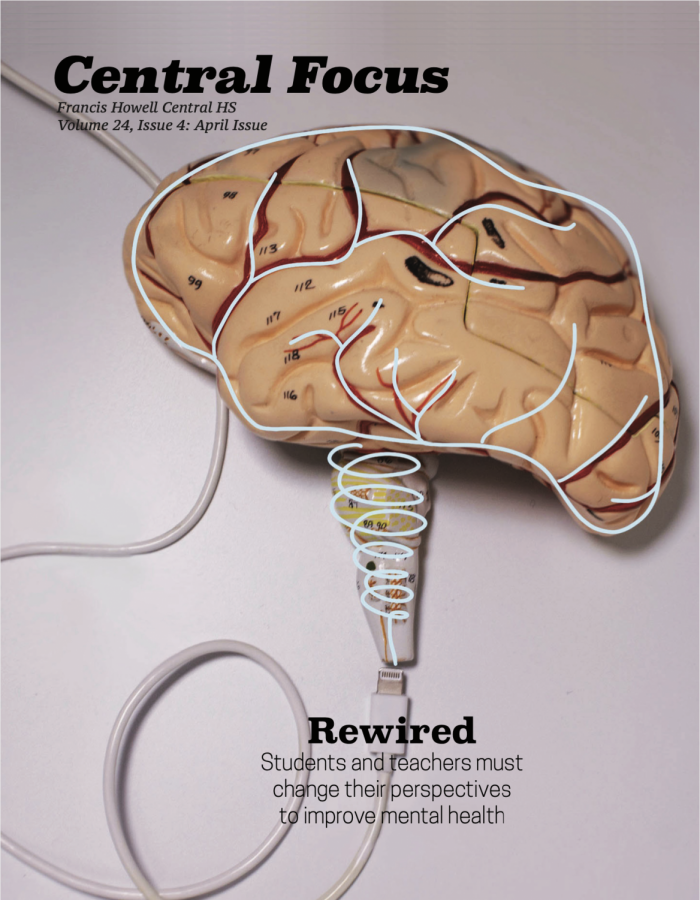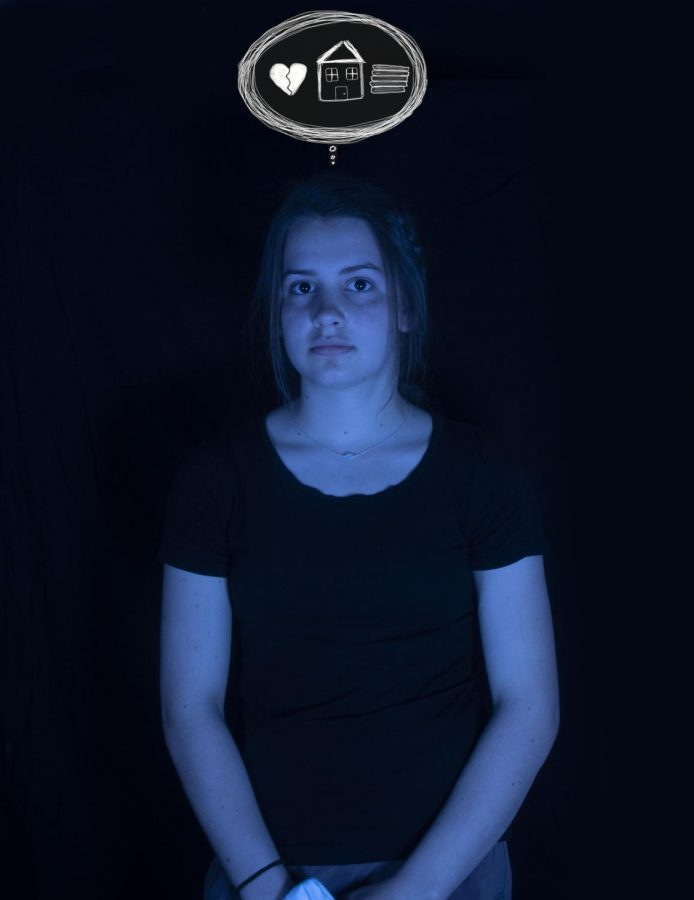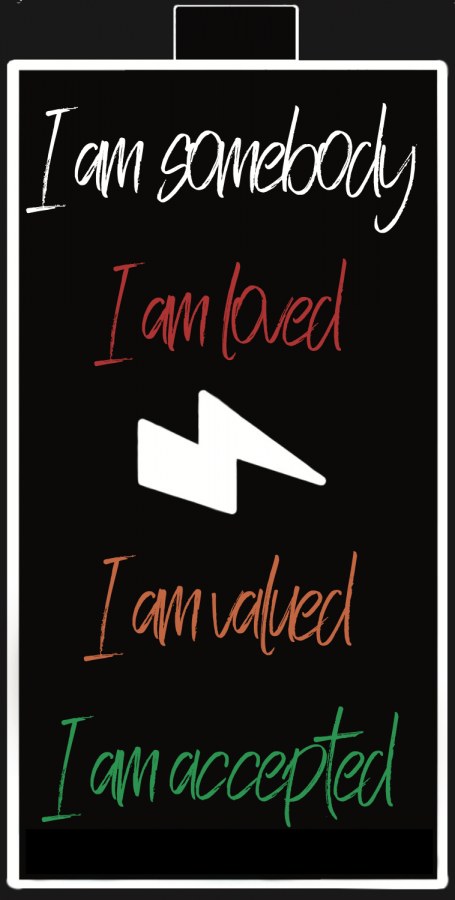Your donation will support the student journalists of Francis Howell Central High School. Your contribution will allow us to purchase equipment and cover our annual website hosting costs. FHCToday.com and our subsequent publications are dedicated to the students by the students. We hope you consider donating to allow us to continue our mission of a connected and well-informed student body.
A dead phone sits plugged into a charger. The phone represents mental health, which must stay energized to keep a person from mentally crashing.
Battling Low Battery
Students struggle to stay mentally charged
There are several obstacles that we face that drain us. Our homework load, jobs, sports, and activities name a few. We charge ourselves through sleep where we obtain the energy to surge through the upcoming days. Sometimes, sleeping isn’t enough. Our mental batteries have to be charged too. But instead of getting the help we need, we push ourselves as far as we can go. We run on one percent, attempting to act as though we are fine when we are everything but. And when we acknowledge our need for help, it’s too late.
We crash.
Professionals, coping mechanisms, trusted adults, and several other solutions can help you face your mental health. It doesn’t matter what outlet you choose to plug into, what matters is that you find what works for you. What matters is that you get charged and stay charged.
Recognizing the Roots
An important part of a mental health journey is understanding sources of these issues
A teenage girl basked in blue light stands with a stoic expression cast onto her face. Above her, a thought bubble floats; it encompasses the causes of her mental distress: relationship and communication issues, home troubles and overwhelming school work. All are example of potential factors that affect mental health.
From an early age, senior Nathan Shaver knew all too well the struggles of battling mental illness. Ranging from social anxiety and sensory issues to depression and manic episodes, Shaver has dealt with mental health issues for what seems like his entire life. Shaver’s earliest recollection of emotional troubles began in early childhood, around the age of two or three years old. Unlike tantrums typical of his peers, Shaver suffered such extreme inability to process his emotions that he was often completely unable to function.
By age seven, Shaver had his first of numerous suicide attempts. At this point, his parents knew he was in need of psychological care only a professional could offer, so he began the journey of receiving help for his emotional wellbeing.
Because of his extensive experiences with mental health, Shaver knows the importance of finding the roots of issues. As a child, however, he struggled with recognizing why he faced the emotions and situations he went through on a daily basis.
“Before having this knowledge [about the causes of my mental health issues,] I was unaware of the cause for my mental or social problems and thought there was nothing to do to be able to move past them,” Shaver said. “I also had numerous things stacking [on] top of the depression including severe, and at the time, undiagnosed ADHD [and] sensory issues. I generally just felt bad about myself and thought that that was how life was supposed to be forever.”
Shaver’s process with discovering the sources of his mental health issues began in therapy, where he received diagnoses, medications, and counseling.
“I got put [on] meds, and was honest about how they made me feel… [I] regularly saw a therapist, who took time to find as they weren’t the first one I spoke with… When my father took me to a mental hospital… [I realized this] isn’t something that is solved by committing suicide but by working on the issues. In short, I guess it was when I realized the problems I was having weren’t normal,” Shaver said.
For senior Katie White, the situation surrounding the causes of her mental health battle is completely different. Before White’s freshman year, she experienced the losses of two family members with whom she was very close.
“I think the cause of this was from my grandma and aunt passing away in the span of three months, and I was just entering high school which was also kind of scary,” White said.
Among dealing with the loss of her loved ones, strain on her relationships with her immediate family members and loneliness from the pandemic, White was eventually unable to cope on her own.
“After running away from my home and constantly fighting with everyone in my family, I accepted the fact that deep down, I wasn’t happy and needed to talk to someone,” White said. “My mom was understanding about me struggling… [and] got me a therapist and I have been talking to her for about a year.”
Rather than being a specific event or stressor in Shaver’s life, he deems the mental illnesses themselves as the cause for his emotional turmoil.
“I’ve got pretty severe ADHD, but I also go through regular spouts of chronic depression and just generally have some heavy anxiety about certain things. I think that in my case… it is just something that is rather than something with a direct cause,” Shaver said.
Though Shaver doesn’t attribute his mental health struggles to one specific factor, he does stress the importance of identifying the elements that contribute to emotional unwellness, whether they be literal stressors or underlying mental health conditions.
“Without knowing why, it’s difficult and even impossible to know what to do to change and alleviate some of the problems you might be facing,” Shaver said.
Shaver adds that, without understanding the origins of mental troubles, it is significantly harder to remove or reduce their presence in your life. Shaver’s advice is to reach out to a loved one, even if you’re not quite sure what specifically is troubling you.
“People need breaks from stressors. If you need help, ask,” Shaver said. “Regardless of what type of issue or severity of your issues or problems or struggles, everybody needs somebody sometimes.”
Managing Mental Health
Destigmatizing emotional troubles is the first step in understanding it
An adolescent girl stands, her face emotionless. The drained battery plastered onto her temple represents the lack of mental energy caused by mental issues.
Mental health has long been surrounded by a stigma of fear and shame, but in recent years, the recognition and knowledge about the subject has considerably opened up. The ideas that once surrounded issues of mental health seemed to fade. With the new wave of awareness, people grew skeptical of the sudden ‘problems’ people had when they reached out, and were accused of being fake. It was seen as an easy path for attention when no one could prove or disprove their claim. Those who struggled regressed into hesitancy and doubt again, captive to their own mind in a battle for legitimacy. Suddenly, caught between the two pulling tides, the silent victims were again tossed aside in the clashing world of conflicting stigmas and doubts, and because of the recent movements and attention brought to the subject of mental health, those who struggle find it harder to access help as they now face two stigmas: one of being fake, and the other of being feared.
Amidst this, their voices still need to be heard. The silence doesn’t mean they’re better. If anything, they need more support than ever. And they shouldn’t have to wait until they feel broken to get help. None of us should.
We need to normalize asking for help, not just for those who’s struggle is visible, but for anyone who wants to reach out at any time. We shouldn’t have to fight mental illness alone until it gets ‘bad enough’ to seek help. We shouldn’t have to wait for an opportunity where we can go see a counselor in quiet and shame.
Educational and Support Counselor Shannon Harting helps eliminate the barriers between mental, social, and emotional health and academic success. For her, the stereotypes and stigmas surrounding mental health are nothing new, and she understands the hesitancy students may face when reaching out.
“If you notice that you have a change in enjoying activities, or being engaged in life, or really able to connect and focus to the goals that you have. That’s when you’re like ‘okay I need someone to bounce ideas off of and help with’… if there’s a significant problem that you’re encountering that you just need some help kind of figuring out how to navigate, that’s kind of the time to go,” Harting said.
The stigma of fear surrounding mental health stems from a lack of understanding and false portrayal. As our knowledge about mental health increases, so does our ability to open up about the subject.
“If you have some need where you need a therapist or where you need, let’s say an antidepressant, [people might] think that that is going to be like the rest of [their] life…that it’s forever. And I even see that with parents…a lot of concern about putting a student on a medication is because they don’t want them to have to have that forever, [but] that’s not really accurate anymore,” Harting said.
Overcoming the stigma surrounding mental health will start with an understanding of the topic and help us all better reach out when we want help. No one should have to wait to feel broken to help take care of themselves.
“[Mental health] is a part of physical health, no different than taking care of your body, and it needs to be an active intentional thing you do to take care of your mind and your emotions so that you can achieve exactly what you want and be who you want to be,” Harting said.
Mental Illness, Meds and Me
Sydney Tran shares her story about mental health
The hardest part isn’t the mental illness, the hardest part is stepping out of your comfort zone to fight it. It took me years to get help because it was easier to talk to friends than my parents. But, the difference between friends and parents is: your friends don’t sign consent forms for therapy.
My mom always believed that mental illness is the direct road to the insane asylum, which led to a preconceived notion that if I had mental illness I too would be committed to a hospital. Even today she still says, “You are normal.”
But, with everything I’ve been through, I know I am not. From my skin picking disorder to my lack of a will to live, I knew something was wrong and I haven’t been “myself” in a long time.
I had seen four therapists.
The first, I cannot remember her name, was a family therapist and I loved her. But when she told my mom, “Rosie if you believe in God then why do you try to play God by controlling your children?”, my mom completely disliked her immediately. This woman was the first person who heard me, and after that appointment, I never got to see her again.
The next therapist was Randy, our family’s second therapist. Randy was okay, I don’t really like him because he had insinuated my own self harm issues were an act of rebellion against my parents, which was out of line. It was only my first visit with him, and after that, I never saw him again.
Then there was Kathryn. I had spilled my heart out to her, I had been going through so many self harm issues I couldn’t take the weight anymore. But, I had only gotten to see her once. And then she never answered my messages after COVID.
But now I have Alex, and she is everything I could ever want. I see her once a week and fill her in on what is going on. The best part is she tailors the sessions to my interests. We do lots of drawing for therapy, and honestly, after the first two sessions, I had felt like my life was the same. After the third, I felt like it was getting pointless. But I realized as I saw her more and more I felt better. I got to experience different activities that helped me visualize and get in touch with my emotions.
Such as playing with “trauma sand” to visualize the overstimulation I experience in school. Trauma sand is just sand in a box. But, then add certain objects such as animals, plants, people to represent how you feel. You just think it’s just objects in the sand but then you start to notice the hidden meanings and symbolism that help you become “one with your emotions”.
And the more I talked I realized I started opening up more in my social life. I remember saying, “For a long time I felt like I was better off alone, but it was really just me cutting off the world because it felt like the world was cutting me off.” That was how my depression felt.
The reason I love therapy so much and strongly advocate for everyone to see a therapist at least once in their life is because it provides time for you. Once a week for an hour I get time to look after my mental health and talk about what has been putting me down for years. It’s my time to let go, and find myself.
But, as you can see, it takes time to find someone who works for you. For a lot of people, many factors go
into finding the therapist for them. Flexibility, chemistry, availability, and money are all crucial for a good fit. Money was a big one for me, and thanks to the resources offered by the behavioral support specialist, I was able to find a free therapist. But there is more than talk therapy for people with mental illness, there’s also medication.
Before I had started seeing Alex, I had met with a psychiatrist to get a step in the door and during my first session she said I was at risk for a personality disorder. I had to take the medication and the therapy seriously if I wanted things to get better. And that was the first time someone other than myself has told me that. Because in reality, I had to be serious about what I was going through, and determined to find help, or else I wouldn’t have had a psychiatrist or therapist.
I first started with Prozac at a baseline dose. It came in a teal green capsule and I picked up the prescription the day she prescribed it because I wanted to start as soon as I could. The weird thing was, I was actually losing sleep at first and I couldn’t shake the feeling of being in my skin. I would be sitting in school, and it would feel like there was a suit on me, and it was constricting me but it was just my skin.
After two weeks of Prozac, I had missed almost a week of school because I couldn’t get up. I thought about going to school but my body said “No, stay here.” I was so frustrated, it wasn’t as simple as walking out the door for me. My parents were furious; they were expecting me to get better immediately after three therapy sessions and a few weeks of meds.
It took a long time to get used to the medication but coupled with therapy, it helped me a lot. I found myself outside of the house more, and my skin picking happened relatively less frequently. The next thing I knew, I was back at the psychiatrist’s office, and my meds were upped. The pills went from green capsules to half white and half green capsules. After a week, I felt overwhelmed. My head felt like it was being twisted and turned upside down with a blanket of headache on me. I feel it the worst in Spanish class. The class is loud, which usually didn’t bother me, until all of a sudden I felt suffocated by everyone’s conversation. It was like I had super hearing and heard what everyone in their pod were talking about, and I couldn’t take it. I had to open a window and stick my head out to feel a release from the chokehold of overstimulation. For the most part, I now experience overstimulation and headaches. But, overstimulation is the worst. It’s hard coming to school every day on time when I know I didn’t want to. I feel the pressure to get better faster and sometimes crack. Still, I see the progress I’ve made. I see that I get out of bed with more confidence in the morning. I see that I am getting out of the house instead of hiding in my room. I see I finally turned in some of my homework assignments that I used to ignore. But most importantly I start to see more of myself when I look in the mirror, and she’s not the girl I used to know. She’s the girl I want to know and I know I have to push through it to find her. I worked so hard to get into therapy and I want it to pay off.
So if you are considering getting help, from a mentally ill person doing the work, do it. Don’t put it off. And when you decide to, understand it’s hard, and it takes time to truly get in the rhythm of the treatment, the highs and the lows you experience. It’s important to know that it takes time, even years. It sounds daunting, but once you get started the challenge isn’t going to be where to begin, it’s going to be figuring out how to keep going. And once you keep trudging along the bad days where getting out of bed seems impossible and the days where it seems like there is nothing else, you start to see who you can be. Someone who is strong enough to fight for you, loves you, and is truly you. It’s not about fixing you, it’s about finding you
Mental Health and Wellness
Coach Radigan creates a safe space for students in his classes
Coach Radigan starts each class period by having his students repeat the identity statement. it is a series of “I” statements to make students aware of how they are cherished.
Walking into class, I was feeling down. Life was difficult. There had been lots of overwhelming factors I could not control. Hours of homework, two-and-a-half hour sports practice every day, work four days a week, drowning in scholarship applications, prepping for graduation, and the inevitable fear of having to leave my family for college. It all seemed to be too much, taking a toll on my mental health. It felt as though no one valued me for doing what I did every day.
I sat down at my desk with a few friends and waited for class to start as I was in a vivid haze thinking about my situation. I heard the door open and in walked my teacher, Mr. Radigan. I heard, “Good morning everyone! Identity statement let’s go…” and I glanced up at the board saying, “I am somebody, I am loved, I am valued, I am respected.” Radigan responds, “And don’t you forget it.” Instantly, I began to feel a little bit better. Like I had a bit more value than what I was feeling deep down. I realized somebody knew me, and my situation, and held value within me. It felt inspiring.
Mental health is a huge problem among our youth and the CDC says one in five children suffer from a mental illness.
Figuring out how to solve this issue is an additional problem. When does a kid know when to get help? How do they get help? How can adults support youth?
Coach Malach Radigan makes sure to create a safe space for students and their mental health. Especially through his Teen Health and Wellness class, Radigan advocates for the importance of being vulnerable about how you’re feeling and the value of each of his students.
“So I share with my kids the Teen Health and Wellness class is a journey and discovery of who you are? How did you get where you are today? Who do you want to become? And how do you get there?” Radigan said. “I really want my kids to walk out of that classroom a better version of themselves mentally and emotionally.”
Coach Radigan’s classroom contains a curriculum based on the value of a student and how they can tell their story.
“Our curriculum centers around that we work on the process of emotions, the process of storytelling, the process of memory imprints as far back as we can remember, and the process of how decision making affects us and our brains,” Coach Radigan said. “My biggest goal is for my students to delve deep into the processing information like how do they make decisions, what are their values, and explore that by doing a lot of reflective work.”
In order to get his students to be vulnerable and open up about their mental health, Coach Radigan creates a safe environment with a personal relation to his kids.
“I am very transparent on how I am as a teacher coming from a really broken background and coming from a lifestyle almost leading me into prison,” Coach Radigan said.
Senior Beth Wilkerson feels Radigan sharing his own life story is extremely impactful to the classroom setting.
“Sharing his story is proof that just because you’re on a bad path does not mean you can’t straighten yourself up and become truly happy with life.”
Coach Radigan relates to his students using his own personal trauma and mental struggles from his childhood and throughout his time growing up. Growing up with a father who was in and out of the picture, a mom working two jobs to keep things afloat and older brothers not being the best influences for him are all parts of his story he shares with his students in hopes to get them to see he has trauma just like them.
He hopes that they will begin to see how everyone has trauma and causes of negative mental health, and in hopes to see sharing their trauma can help improve their mental health the way it has for himself.
“They see a side of me that shows realness and struggle and how that happens,” Radigan said. “Typically with sharing my story, kids will either open up to me a lot more or they respect my story a lot and they choose to open up through their assignments.”
Senior Emily Crass felt she was able to share her own family experiences, with a very positive reaction from peers, after being able to hear Coach Radigan’s.
“Talking about my childhood and the stuff me and my family have been through, everyone in the class was super respectful,” Crass said. “Even after I got feedback from the students around me.”
In addition to sharing his own stories, Coach Radigan created a daily statement to make sure his kids feel loved the second they walk into his classroom.
“I always start with the identity statement,” Coach Radigan said. “The identity statement is ‘I am somebody, I am loved, I am valued, I am accepted.”
Senior Ella Harper agrees that Coach Radigan’s identity statement reassures her value as a student and in the classroom itself.
“The Identity statement is really nice. I love the energy it brings into the classroom,” Harper said. “Hearing everyone saying it and hearing myself say it makes me realize Radigan really cares about his students.”
Kids today feel endless amounts of stress from the nature of school and the future. Many students feel their value is based on how their achievement within the school and what their plan is past high school education, resulting in their feeling of a lesser value.
“Unfortunately, our education system puts value in kids based on their GPA and society puts value into you based on your job title,” Radigan said.
Radigan makes an active effort in making sure kids understand they are more than a grade on a paper or a job description.
“I really try to let kids know no matter what happens in the world I hope when you come into my classroom you feel one of the four things in the identity statement,” Radigan said.
Upon seeing his students become truly vulnerable in front of each other, Radigan has had his fair share of emotions.
“There have been times where I have been drawn to tears because of watching these true deeper friendships develop from these kids being true, real, deep, and bold,” Radigan said. “There is an overwhelming joy when I walk in and I am seeing the class interact without me having to prompt them.”
Harper and Crass use Radigan’s classroom as an opportunity for a mental health release.
“Everyone is so nice to each other and it is like a big group therapy session every day.” Harper said, “While sharing about my depression and explaining I have had to go to the hospital everyone was willing to be like ‘Hey I’m proud of you.’ And no one really understands how much those words mean.”
Crass agrees with Harper that Radigan’s class is set up to be a great mental health outlet for students with positive interaction.
“It is always safe. I always feel respected with what I share and open up about.” Crass said. “I always make an effort to be respectful when someone else is talking about what they have been through in class.”
Radigan’s biggest goal is to see his students feel they are able to be vulnerable about their mental health and trauma within his created safe space.
“The most rewarding thing is seeing breakthroughs for students and seeing a kid grow from the first week we did a project to the end really doing the work,” Radigan said. “Seeing kids having these relationships with me and their peers in this environment and being vulnerable is the most rewarding thing.”
A soft blue glow shrouds the Thrive Rom in an aura of calm. The Thrive Room, or Behavioral Specialist Room, is a place where students can go to destress in times of mental anguish, as well as receive resources for mental health troubles.
Helping Students Thrive
Behavioral specialist offers comfort to struggling adolescents
When walking into the Thrive Room, one is met with an ambiance unlike any other seen on the rest of campus. Lights are dimmed, while sensory lights emit a soft blue glow. Mrs. Kalinda Dixon is there ready to welcome any student who stops by. Mrs. Dixon is the behavior support specialist that works in the Thrive Room, located near the main office, a specialized room designed to be an oasis for those in need of an escape from the stressors of school.
“[The purpose of the room is] to come back to the reality of what’s going on, instead of veering off into those life stressors, or getting really tied up in a tornado effect spiraling out of control,” Mrs. Dixon said. In order to go about contacting her and becoming a regular to the Thrive Room, one must go through their counselor first.
“If [a student] needs support then, by all means, come,” Mrs. Dixon said. “But, eventually, I’m going to have to get them to their counselor. I can’t work with them on a daily basis until they get referred.” In the hierarchy of mental health outlets, the Thrive Room is one of the first places to go. For students struggling with surface-level anxiety or stress, Mrs. Dixon provides the tools to cope with those issues.
“I’m more of a skills coach for teaching coping skills… I guide [students] through mindfulness or through breathing techniques,” Mrs. Dixon explained.
When a student comes into the Thrive Room they sign-in and fill out a questionnaire, then they have time to sit and get settled before jumping into a discussion with Mrs. Dixon. She works with these students and problem solves through their unique situations, figuring out what techniques that student is using to cope, and from there trying to implement one more technique to get through whatever hardship they may be facing.
While not intended to help those in crisis situations, the Thrive Room is a place where students can unwind and find solace in their mind-numbingly hectic days. Mrs. Dixon is there to listen and help any student struggling with their mental health.
“This is a no-judgment zone,” Mrs. Dixon said. “There’s no ‘I don’t know,’ ‘You can’t say this,’ ‘You can’t say that.’ It’s on the table.”
When looking for mental health outlets at school, the counselor’s office is what most think of first. There is a stigma surrounding the counselor’s office in that it is simply a place to get a schedule changed or to obtain a transcript, but each counselor is properly trained in dealing with mental health issues all across the board. Counselor Mr. Kris Miller finds that many students do indeed seek help from their counselor.
“We do spend a lot of time on the mental health needs of students, so we’ve seen that growing over the course of the last decade,” Mr. Miller said. “It’s not many days and not many weeks go by where I don’t have a crisis [to deal with].”
There are many ways to go about contacting a counselor, such as using the QR codes posted around the building or even just stopping in during passing periods. Someone will always be available to help. A majority of the staff in the counselor’s office is equipped to handle the many situations that may arise in regards to a student’s mental health.
“We’ve all had some training, but different members of our team have different varying levels of that background,” Mr. Miller said. “About half of us come from mental health backgrounds, a couple of people in our department are licensed therapists and licensed clinical social workers.”
Mr. Miller himself was a mental health counselor who worked with adolescents dealing with drug and alcohol problems. However, there does come a point where the school-provided counselors are unable to assist with a student’s problems, such as when that student is in danger of harm, or if what the counselor is providing is simply not enough.
“We are not therapists, I can sit and help a student periodically… but anything beyond the occasional check- in, we’re probably going to be limited, just because of the amount of other things we have to do,” Mr. Miller said.
Beyond the school resources, there are many things a student can do to reach out and get help. There are hotlines, online resources, and therapists that are all readily available to the public. Licensed professional counselor, Celeste Daiber, explains how one can go about finding the right therapist.
“It will depend on a lot of factors… like insurance and availability and personal preferences,” Daiber said. “PsychologyToday.com has an excellent find a therapist search engine that might be very helpful, especially if you have to work within insurance constraints.”
For those in immediate crisis situations, she recommends a multitude of hotlines, such as the Youth Connection hotlines, the SAMSA National Health hotlines, and the Disaster Distress Helpline. Sometimes hotlines are the only means of aid one can receive at the moment.
“I prefer face-to-face [therapy], but sometimes that’s not feasible,” Daiber said. “If you feel as though you’re in danger, like immediate danger, getting yourself in front of professionals ASAP is going to be the first step.”
There is a wide range of therapists available, each often specializes in a specific area.
“There are different modalities of therapy that will treat different issues… [for example] there are therapists that specialize in eating disorders… there’s a lot of different ways to go about presenting in therapy or therapy modalities,” Daiber said.
Daiber personally specializes in EMDR (Eye Movement Desensitization and Reprocessing therapy), which is therapy specifically for trauma situations. Through these different avenues of issues, there are different avenues of assistance.
“Education is a part of therapy very often… it depends on the person and their style of learning,” Daiber said. “I do a lot with hands-on, physicalizing things, we work on a lot of coping tools. There’s no wrong way to go about [seeking help]… the only wrong way is to not do anything,” Daiber said.
Whether speaking to the school counselors, spending an hour in the Thrive room, or contacting a professional therapist, seeking help for mental health is an incredibly important step. With as many outlets and resources as there are available to students, they should never feel lost in where to go.
“We really want to help these kids, we want them to have somebody to listen to them,” Mr. Miller said. “I always tell my students that if they have nowhere else to turn in the building… or get support from, come to me.”
Students should know that it’s always okay to reach out for help.
“I know [students] probably hear this a lot, but it’s okay if you’re struggling to be vulnerable, to be transparent,” Mrs. Dixon said. “If you’re not able to cope with whatever it is that you’re dealing with by yourself, there’s always help, my doors are always open.”
Students should never feel as though their mental health should come second.
“It’s not like you’re weak [or] you’re dramatic, you know the labels that adults want to put on adolescents,” Daiber said. “You don’t need to be fixed. You need to be heard.”








Harold A Maio • Apr 26, 2021 at 12:47 pm
—-Mental health has long been surrounded by a stigma of fear and shame
You are missing significant language: We have long been taught that. We are learning slowly to reject that lesson.
Harold A Maio